On Willow Pond
Tom Caruso of Smithtown snapped this photo of Willow Pond at Smithtown’s Caleb Smith State Park Preserve in all its fall splendor on the morning of Oct. 28.
Send your Photo of the Week to [email protected].
On Willow Pond
Tom Caruso of Smithtown snapped this photo of Willow Pond at Smithtown’s Caleb Smith State Park Preserve in all its fall splendor on the morning of Oct. 28.
Send your Photo of the Week to [email protected].
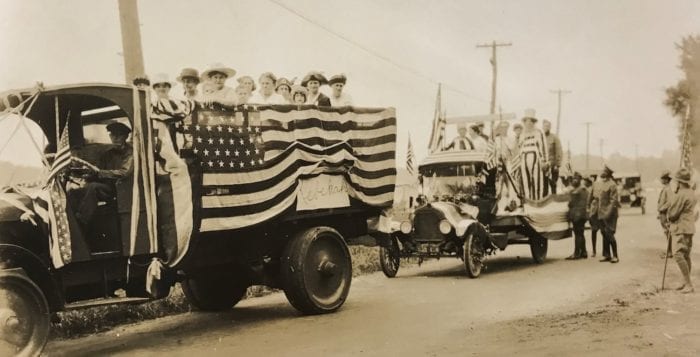
By Beverly C. Tyler
It was Nov. 11, 1918, and World War I had come to an end for the Americans fighting in Europe.
Two who did not return to Setauket were memorialized at a ceremony on the Village Green at the end of a parade Sept. 1, 1919, as reported by the Port Jefferson Times.
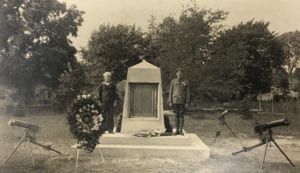
“With the service men in uniform standing stiffly at attention and the civilians with bared heads, the entire assemblage united in singing ‘America’ and the Rev. T.J. Elms opened the meeting with a prayer. Judge Watson then introduced the speakers of the day, the first being Admiral Niblack. Admiral Niblack made many friends when he was here with the fleet last summer, many of whom were in the crowd.
“The Rev. T.J. Elms then dedicated a rock to the memory of the Setauket boys who died in the war — Raymond Wishart and Harry Golden. The Community Chorus, led by Mr. & Mrs. W.H. Stewart Jr., sang a patriotic song and an army officer addressed the gathering.
“Those boys of Setauket who had been denied the privilege of giving their lives in the great cause were then presented with suitably inscribed medals. Mrs. Wishart received a medal for her son and Mr. Golden for his boy. The ceremonies concluded with a benediction by Father Roex and the singing of ‘The Star-Spangled Banner.’”
A plaque, originally placed in a monument on the grounds of the East Setauket Veterans Memorial is now in the entrance foyer of the Setauket Elementary School. The memorial metal plaque reads: “Erected in honor of those of Setauket and East Setauket who served in the World War.”
Those named are: Irving R Addis, Thomas F. Bowen, Edwin Brown, Fred K.M. Brown, Jacob Brown, James Brown, Joel W. Brown, Wilson Brown, John H. Bristol, Lewellyn Bristol, Edwin M. Bryant, Charles Buchanan, Leroy J. Buchanan, Charles Buehrman, William J. Byron, Eversley Childs Jr., William H.H. Childs, John Darling, Louis L. Darling, Roger P. Dodge, Mary Elderkin, Julius Freedman, Louis Freedman, Nathan Gerstein, Howard Gibb, Harry Golden, Leon Goldberg, Max Goldberg, Edward T. Grahm, Alfred A. Hawkins, Floyd B. Hawkins, Daniel H. Hawkins, George R. Hawkins, Irving Hart, William B. Hart, Leo M. Heath, Hattie D. Jayne, Lester H. Jayne, Theodore Junk, Cornelius Kiendl, Theodore Kiendl, Oliver D. Lyon, Ralph S. Lyon, Archibald McLaren, Percy W. Macauley, George R. Mohlman, David A. O’Leary, John A. Payne M.D., Walter W. Peters, Edward H. Pfeiffer, William F. Pfeiffer, Samuel Pinnes, Russell G. Rogers, C. Lawrence Rossiter Jr., Frank F. Schields, Silas Seaman, Albert Sells, Charles W. Sells, Joseph Sells, William S. Sells, Willis H. Skidmore, Marco C. Smith Jr., Frank L. Stenken, Caroline H. Strong, Thomas S. Strong, Harold Terrell, Raymond L. Terrell, Annie R. Tinker, Edward L. Tinker, Handford M. Twitchell, Pierrepont E. Twitchell, Leon J. Tyler, John Walker, Harvey H. West, George H. West, Ernest West, Percy H. West, David L. Wishart, Raymond Wishart, Stanley G. Wood.
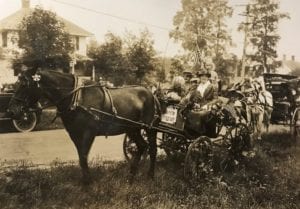
There is no existing plaque or memorial for the men from Stony Brook who served in World War I. However, a card file of nearly 4,500 World War I veterans was made by the Suffolk County Records Committee and listed these names for Stony Brook:
James Wesley Beldon, Ernest Merwin Bennett, John Oscar Bennett, Stephen Bochinski, Archibald Manning Brown, Nelson David Combs, Frederick Ebenezer Darling, Russell Eugene Darling, George Vincent Davis, Lee Fitshugh Davis, William Sidney Davis, Alexander Findlay, Ross Comrade Findlay, Joseph Gumbus, Frederick Brewster Hawkins, Homer Stanley Hawkins, Charles Lundgren, Frederick A. Mielke, Herman Oakley Newton, Herbert Nichols, Charles Clifford Peterman, Arthur LeRoy Platt, Benjamin Merton Powell, Stanley Russell Rogers, Frank Anton Schaefer, George Washington Schaefer, Paul Eugene Schaefer, William Henry Harrison Shipman, Jay Lawrence Smith, Robert Merwin Smith, Joseph Stufkosky, Robert Hawkins Topping, George Aloysius Wilson, Wilmot Smith Wood, Richard Lawrence Woodhull, Charles Halsey Young.
Remembering … this year
The U.S. World War One Centennial Commission — along with the Pritzker Military Museum & Library, the Society of the Honor Guard: Tomb of the Unknown Soldier, the American Legion and the Veterans of Foreign Wars — is inviting American citizens and organizations to toll bells in their communities as a WWI remembrance. The event, Bells of Peace: A World War I Remembrance, will take place Sunday, Nov. 11, at 11 a.m. local time.
The centennial commission has created a page on its website: www.ww1cc.org/bells.
The National World War I Museum and Memorial, in Kansas City, Missouri, opened in 2006 to national acclaim. Since then, more than two million people have visited the museum including Frank Buckles, America’s last surviving WWI veteran, who visited the museum and memorial over Memorial Day weekend in 2008. During World War II, he was captured and spent three-and-a-half years in Japanese prison camps at Santo Tomas and Los Baños in the Philippines. Buckles died Feb. 27, 2011, in Charles Town, West Virginia, at the age of 110.
In 2014, the museum and memorial received a second designation from Congress, effectively recognizing it as a national memorial. The museum is “dedicated to remembering, interpreting and understanding the Great War and its enduring impact on the global community.”
The museum began as the Liberty Memorial, dedicated Nov. 11, 1926, by President Calvin Coolidge who said the memorial “has not been raised to commemorate war and victory, but rather the results of war and victory which are embodied in peace and liberty. … Today I return in order that I may place the official sanction of the national government upon one of the most elaborate and impressive memorials that adorn our country. The magnitude of this memorial, and the broad base of popular support on which it rests, can scarcely fail to excite national wonder and admiration.”
The Liberty Memorial began as a dynamic addition to Kansas City’s cultural offerings, but by 1994, it had to be closed due to safety concerns. Then state, federal and individual donors raised $102 million for the memorial, and an extensive museum restoration and expansion. In 2004, the building was designated by Congress as the nation’s official World War I Museum, and construction started on a new 80,000-square-foot, state-of-the-art museum with the Edward Jones Research Center underneath the memorial. The site was designated a National Historic Landmark Sept. 20, 2006.
Beverly C. Tyler is Three Village Historical Society historian and author of books available from the society at 93 North Country Road, Setauket. For more information, call 631-751-3730 or visit www.tvhs.org.
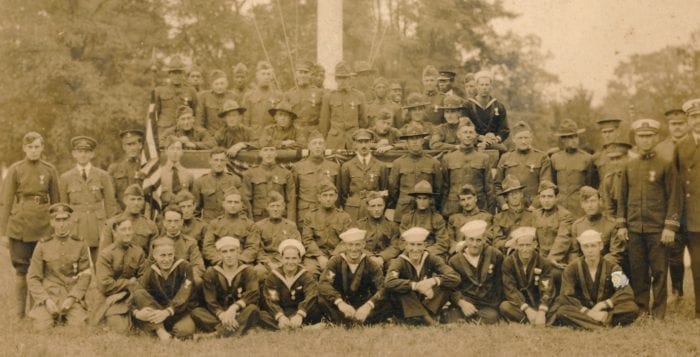
By Beverly C. Tyler
“Victory and Peace,” the headline proclaimed, “War Ends — Fighting Ceased at 6 a.m. Monday.” It was Nov. 11, 1918, and World War I had come to an end for the Americans fighting in Europe. In a railway car in the French Forest of Compiègne, at 5 a.m., the German delegates accepted the strict terms of the armistice and at 11 o’clock that morning the world war came to an end.
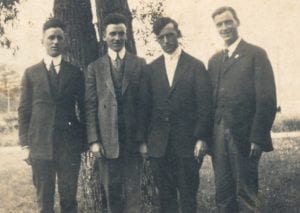
President Woodrow Wilson that morning issued a proclamation that said, “My fellow countrymen. The armistice was signed this morning. Everything for which America fought has been accomplished. It will now be our fortunate duty to assist by example, by sober friendly council and by material aid in the establishment of just democracy throughout the world.”
The men and women who served in “the war to end all wars” were coming home. Many of the soldiers were suffering from what they called “shell shock.” Today we know it as post-traumatic stress or simply PTS. Other world war soldiers were gassed. In many of these cases soldiers came home without revealing their need for help. In other cases, soldiers were treated and released back into civilian life with or without continued care. Many soldiers never recovered from their wartime experiences.
The following year, after the soldiers and sailors had returned home, a celebration, parade and memorial service was held Labor Day, Sept. 1, 1919. As reported by the Port Jefferson Times, “All Setauket was there and most of Long Island by the appearance, for long before the time scheduled for the start of the procession, automobiles began to line the road on either side. Promptly at 2:30 p.m. the 42nd Infantry Band from Camp Upton led the parade away from the dock at East Setauket.”
The parade continued along Shore Road from the harbor and then paused while the Rev. A.Y. Holter dedicated the new East Setauket Park in honor of those who served in the war. The parade then re-formed and proceeded up Main Street, turning right at the Methodist Church and continuing to the Village Green.
The parade brought out many local groups and some $5 gold pieces were awarded as prizes. The award for the best decorated carriage went to Henry Smith of Setauket whose buggy was decorated with pumpkins and other farm products. One of the decorated trucks that didn’t win a prize was in the shape of a submarine chaser, with real guns mounted fore and aft. Among the groups that marched were the mechanics of Setauket and Port Jefferson and 70 or so soldiers and sailors who later posed for a picture on the Village Green. Others in the parade included a car filled with men who had fought in the Civil War, men on horseback, decorated trucks carrying members of various organizations and school children carrying a “Welcome Home” sign.
Muriel Hawkins, of East Setauket, daughter of Clinton West, remembered the parade and how her uncle Ernest West, who was a ship’s carpenter in the Navy, made seven trips across the Atlantic and back during the war. Ernest was one of four brothers who served during the war. The other three, George, Harvey and Percy were in the Army. All four were the sons of Setauket blacksmith Samuel West and all four returned, in some cases with mental and physical scars that would last the rest of their lives. There was, however, a lot of family support as their father, Samuel West raised 10 children, with help from his own extended family, as his wife, Ida Hulse West, died after the delivery of their 10th child.
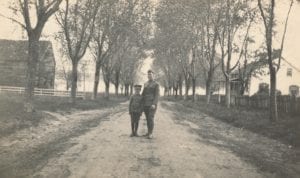
Percy Hulse West was born July 18, 1889, and enlisted in the U.S. Army April 13, 1917. The War Department telegram written Oct. 21, 1918, to his father says, “Deeply regret to inform you that it is officially reported that Private Percy H. West, Infantry was severely wounded in action about August twenty-eight [actually July 10]. Department has no further information. Harris, Acting Adjutant General.” Over the next few months, Percy was transferred to a number of different Army hospitals including Army Hospital No. 3, Rahway, New Jersey.
On Nov. 5, 1918, Clinton West, Town of Brookhaven justice of the peace and Percy’s brother, wrote to Maj. Fayermather at the hospital requesting information “regarding the revoking of the furlough of my brother Private Percy H. West. Father was quite upset as this was Percy’s only furlough since his enlistment in May, 1917. He being the first of our local boys to return from active front line service and crippled, we had planned to give him a good time and a chance to visit his relatives and friends …” On Nov.18, 1918, Samuel West, Percy’s father wrote to Capt. Sellers to request “that Percy might be allowed a little time to see his people [in East Setauket] after the service he has rendered his country.” Additional letters from Selah Strong and H.G. Rogers were received at the hospital with the same requests.
Percy did return after he was discharged March 3, 1919, as he is pictured in the photo of the celebration on the Setauket Village Green Sept. 1, 1919, as well as a family photo taken the same day with his father and his other three brothers who served in the war.
The following year, the 1920 census lists Percy as living at “Mattawan State Hospital, Beacon, Dutchess County, NY.” In the 1930 census report, Percy was living as a boarder with Fred and Lydia Bartoo (or Barton) in Oxford, Chenango, New York, where he was working at a golf course. Percy died July 6, 1957. Percy’s brother Ernest West returned to East Setauket and continued working there as a carpenter until his death in 1966. Percy’s brother Harvey West, in 1930, was a patient in the Middletown State Homeopathic Hospital in Orange County. He later went to live with his brother George and Elsie West in Stratford, Connecticut. He died in 1967. George West, following World War I and his return home, lived the rest of his life in Connecticut, in 1920 with his sister Hazel West Jayne and her husband Robert Jayne. George married Elsie in 1922 and made his home in Stratford, Connecticut. He died in 1975.
“World War I was the first ‘modern’ war. Industry enabled weapons and explosives to be manufactured in vast quantities that brought death and destruction on a scale never previously experienced by mankind and that affected all combatants. On Sept. 18, 1918, American Sgt. Charles S. Stevenson wrote: “This is the seventh day of the St. Mihiel drive and I find myself sitting in a thick, muddy forest, with my knees and a gas mask as a table, writing to you. It was some drive. Small, in comparison to many operations, to we rookies it was a real battle. Machine guns, rifles, shells, aeroplanes and tanks — everything you read about — I saw ’em all. We followed the first line (the attacking party) for twelve hours and ours was a sort
of ‘after the battle’ review. I saw all kinds of German trenches, barbed wire entanglements, busted houses, burning trees, deep shell holes, torn-up railroad tracks, peaceful gardens, dynamited bridges.All kinds of German prisoners passed me on the way back.” (Exhibition: Fields of Battle, Lands of Peace: The Doughboys 1917-1918 — National World War I Museum, Kansas City, Missouri). This exhibit has been touring the world and is now at the Navy Pier in Chicago, Illinois until Nov. 18.
Beverly C. Tyler is Three Village Historical Society historian and author of books available from the society at 93 North Country Road, Setauket. For more information, call 631-751-3730 or visit www.tvhs.org.
Editor’s note: Armistice Day was changed to Veterans Day in 1954.
Election Day may be over, but the work has just begun.
Political races are not just about the outcomes. Consistent engagement is needed to make actual change once campaigning is over. The momentum we have seen from our community needs to be kept up by members of both political parties, regardless of the 2018 midterm results.
Political engagement starts with voting, but continues with having conversations with elected officials, attending meetings and keeping an eye on meeting agendas. Let the officials know where you stand on critical issues and how you want them to vote while in office to continue to receive your support. Make a call, send an email or set an appointment to meet your state assemblymember, congressional representative or town councilperson at his or her office. Don’t be afraid to ask questions and let your officials know what’s on your mind.
Another key part of civic engagement is having conversations with the people you encounter in everyday life, whether you agree with them or not, and even joining civic associations.
There is no denying that there has been an air of growing divisiveness during the last few years in our country. Conversations across the aisle are needed more than ever.
Those discussions aren’t happening amid disagreements about gun control, health care, taxes and more. Conversations quickly become so heated people who were once friends, or at least cordial acquaintances, avoid each other in supermarkets or delete and block each other on social media rather than talking it through.
We encourage you to take the first steps in saying the chasm forming in this country is unacceptable. Painting swastikas on election signs is unacceptable. Comedians joking about a U.S. congressman with an eye patch saying, “I’m sorry, I know he lost his eye in war, or whatever,” is just not appropriate. Openly promoting racism and encouraging violence goes against fundamental human rights and American principles.
With two years left until the next presidential election, and campaigns warming up already, it’s time to radically change the tone of the nation’s political discourse before it’s too late. People from different political parties can meet up, have intelligent conversations and come to an agreement. Or, simply agree to disagree and respect each other. There used to be a baseline acceptance that differing opinions were just that, and not an indication of evil motives.
Not satisfied with election results or your elected representative? Start demanding political party leaders seek candidates who have fresh, new ideas supported by concrete plans and the knowledge, confidence and energy to get things done, but do it constructively and with an open mind.
Neither party should take anything for granted, nor should President Donald Trump (R). After a turbulent first couple of years, there is serious work that needs to be done to unite our country to get it moving forward, indivisible with liberty and justice for all.
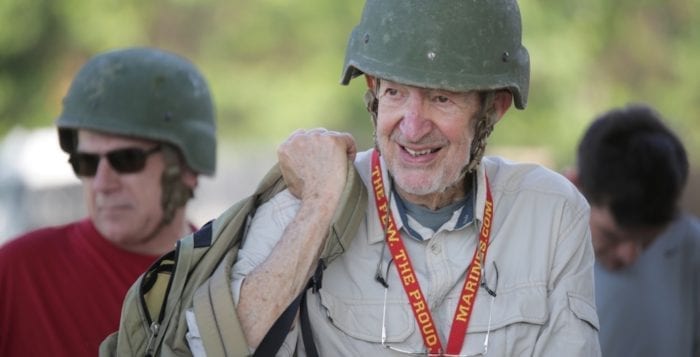
As told to Cathy DeAngelo, vice president of sales and marketing, Jefferson’s Ferry.
Les Paldy is not your average 84-year-old. The Jefferson’s Ferry resident and distinguished service professor emeritus at Stony Brook University has spent more than 50 years teaching in the departments of technology and society, physics, political science and the university’s Honors College. While Paldy has retired, teaching only one class each semester and living with his wife Judy, a retired Three Village Central School District science teacher, in a two-bedroom cottage at Jefferson’s Ferry, he keeps a busy schedule.
“I had trained at Quantico in the 1950s when training methods were relatively primitive. Today’s training is more rigorous, designed to challenge the motivated college graduates competing to become Marine officers.”
— Les Paldy
Paldy, a former Marine infantry and intelligence officer and Korean War veteran, was recently invited to the Marine Corps base at Quantico, Virginia, to observe current Marine officer candidate training during the Marine Corps Recruiting Command’s 2018 Educators and Key Leaders Workshop. He wound up participating at a level he hadn’t anticipated.
“I had trained at Quantico in the 1950s when training methods were relatively primitive,” Paldy said. “Today’s training is more rigorous, designed to challenge the motivated college graduates competing to become Marine officers. On this visit I was assigned to a four-member team given the opportunity to attempt the Leadership Reaction Course involving a set of physical obstacles. The team leader must make a team plan and execute it within a time limit. Marine officer instructors observe to rate the leader and team.”
Paldy said the goal was to retrieve a wounded Marine supposedly held captive by hostiles.
“The physical obstacles consisted of two 8-foot-high platforms separated by a 5-foot gap,” Paldy said. “The team had to scale a wall to the first platform, crawl through a section of conduit pipe, bridge the gap to the second platform and climb down to retrieve the stretcher-borne Marine. Then the team would have to reverse course, re-cross the gap with the wounded Marine on the stretcher, and then lower him to the ground from the first platform. The team had only an 8-foot plank and a short length of rope to work with.”
Paldy volunteered to lead.
“With a separated shoulder and replaced knee, I had planned to stay at the base of the first platform to help lower the casualty to the ground,” Paldy said. “I had no intention of attempting the climbs and gap traversals but one of my teammates was clearly hesitating. It was obvious that we needed three persons to climb up and over to retrieve the wounded Marine. Someone else would have to be the third climber and that person would have to be me.”
“I’ll try to share the excitement of acquiring new knowledge with a younger generation that will have to deal with issues and problems that have eluded us.”
— Les Paldy
Paldy scaled the first wall, bridged the gap between platforms with the plank, and had almost crossed it before losing his balance, falling 8 feet to the ground and becoming a real casualty.
“Probably poor judgment to try it,” he said, “but I didn’t see any alternative.”
He said he gave himself a C-minus for the effort. Course instructors told him he may have the distinction — “dubious,” he said — of being the oldest person to have tried to run the Marine Corps Leadership Reaction Course.
When Paldy is not climbing walls in Marine officer training, he consults with Brookhaven National Laboratory’s Nonproliferation and National Security Department and volunteers as a professor in the Department of Pathology, working to connect Stony Brook medical and engineering researchers with their counterparts at national laboratories and the Naval Submarine Medical Research Laboratory at the submarine base in Groton, Connecticut.
“This Navy lab is the world’s premier research center for submarine medical research, focusing on ways to maintain the health of submarine crews, dedicated men and women whose submarines may stay submerged for months,” Paldy said. “Navy and Stony Brook researchers have exchanged visits and gone aboard attack submarines to discuss possible collaboration.”
He also makes a study of nuclear weapons proliferation and other global concerns and this fall will lead a senior seminar in Stony Brook’s Honors College.
“I’ll try to share the excitement of acquiring new knowledge with a younger generation that will have to deal with issues and problems that have eluded us,” Paldy said. “The university gives me the freedom to work on interesting things with the support of faculty colleagues and professional and civil service staffers who make the university run. No one could ask for more. With some luck, I’ll keep doing it.”


Ward Melville Patriots boys volleyball team hosted Smithtown East Bulls Nov. 2 in the Suffolk County Division I semifinal bracket and swept their opponents in three sets. The Patriots advanced to the Division I volleyball championship.
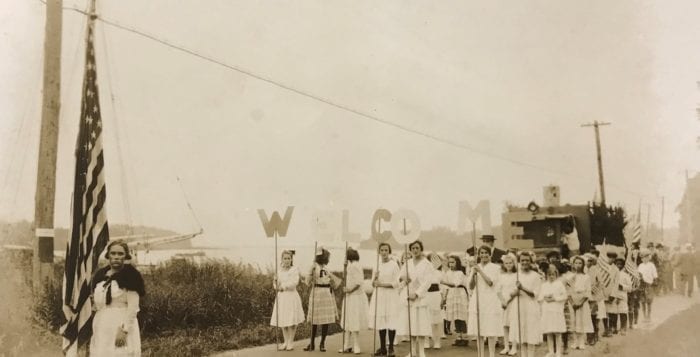
By Charles Morgan
“Der Krieg ist vorbei.” “La guerre est finie.” “The damned thing is ended.” “Let’s git the hell home.”
So it was 100 years ago on Nov. 11, 1918, at 11 a.m. that World War I, the most destructive war in the world at the time, was over. The Germans, French, Austrian-Hungarians, Italians, Turks, British and Americans, among others, had stopped shooting at one another; the Russians had ceased the previous year.
At this single juncture, several empires had fallen: the Hohenzollern of Germany, the Romanov of Russia by internal Communist revolution, the Habsburg of Austria and the Ottoman of Turkey. Even the victors suffered. The British Empire was all but broke; France was gutted; and the United States was becoming aloof as it entered the Roaring Twenties with most people not knowing what the Treaty of Versailles in 1919 was all about. However, there were four more, known as the suburban treaties: St. Germain with Austria, Neuilly with Bulgaria, Trianon with Hungary and Sèvres with Ottoman Turkey. This last one had to be renegotiated at Lausanne in Switzerland in 1923.
Germany had to give up Alsace-Lorraine which it had taken from France in 1870. The Germans were limited to an army no larger than 100,000 men and a navy with manpower not exceeding 15,000, possessing only a limited fleet and absolutely no submarines. There was to be no air force.
Two countries were literally invented. Parts of the Habsburg Empire with Bohemia, Moravia and Slovakia became Czecho-Slovakia. In the Balkans, the Paris peacemakers instituted the Kingdom of Serbs, Croats and Slovenes, later mercifully shortened to Yugoslavia.
The famous T.E. Lawrence of Arabia had helped unify the various desert tribes in the Arab Revolt against the Turkish armies. King Faisal I of Iraq assumed he would be king of it all, but saw his plan nullified by the secret 1916 Sykes-Picot Agreement, which enabled France to take over Syria and Lebanon among other countries, while Britain established protectorates over Palestine and Transjordan. These were called mandates. Eventually, in 1932, a large piece of desert land would be called the Kingdom of Saudi Arabia. The viscous black fluid that soiled the camels’ hooves was to be the future of “the Middle East.”
Disarmament was the outcry, and it engendered a series of treaties the first of which was the Washington Naval Conference of 1921-22. The United States, Britain, Japan, France, Italy and others hammered out a treaty severely limiting construction of warships. It referred mainly to battleships, leaving little consideration of cruisers and aircraft carriers. In effect, this was the first arms-control conference in history. A small coterie of American and Japanese admirals held that aircraft carriers would be the strategic naval weapon of the future — a point disastrously proven Dec. 7, 1941, at Pearl Harbor.
Then came Benito Mussolini. In 1922, he and his followers, called Fascisti, gathered in Rome, allowing King Victor Emmanuel III to remain on the throne, but with Mussolini as Il Duce. His navy was to dominate the Mediterranean, with its state-of-the-art battleships such as the Vittorio Veneto; the Condottieri-class cruisers with flowing names like Eugenio di Savoia; and speedy Soldati-class destroyers. Yet when the Italians clashed with the British Royal Navy as early as 1936 in the Spanish Civil War and later battles, they revealed a lack of leadership as did the land forces.
The fighting had not stopped. The 1918 Treaty of Brest-Litovsk, which took Russia out of the war also ushered in communism. The Spartacists violently took over Bavaria, calling it the People’s State of Bavaria. Demobilized German soldiers made short work of this nascent Communist effort. At the same time, now-Communist Russia under Lenin sent the Red Army into Poland under Marshal Mikhail Tukhachevsky.
In 1920, the Russians pushed back the Poles all the way to the gates of Warsaw. But then came the “Miracle on the Vistula,” when Polish Marshal Józef Pilsudski sent the Reds reeling back to Russia. The Poles, therefore, became the first ever to defeat the Red Army in the field of battle. In 1919 Hungarian revolutionary Béla Kun fomented the Communist revolution in Budapest which was put down by the forces of Regent Miklós Horthy. By 1926, Mustafa Kemal Atatürk in Turkey, who had abolished the caliphate, was making changes designed to convert the country into a secular republic, including taking fezzes and turbans off the men, and introducing the Latin alphabet.
On that November day in 1918 an Austrian corporal, recovering from wounds in a field hospital and sporting a sizable imperial handlebar mustache — later trimmed to a Chaplinesque toothbrush — as well as the Iron Cross 1st Class, was mulling over in the darkest recesses of his mind, a way to avenge Germany’s defeat brought about by the “November Criminals.” His name was Adolf Hitler.
Charles Morgan is a freelance writer from Stony Brook, and gives a personal view of the aftermath of World War I.
Newfield Wolverines varsity boys soccer team contested Walt Whitman High School Nov. 1 for the Suffolk Class AA boys soccer final at Diamond in the Pines, Coram, and lost to the Wildcats, 2-1.
Polls closed in New York at 9 p.m.
Check back for updated results as they come in.
Check out results from the state, federal and local North Shore races as they come in on election night. Follow @TBRnewsmedia on Facebook and Twitter for the latest and search the hashtag #TBRVoters. All results are courtesy of the Suffolk County Board of Elections and the New York State Board of Elections.
1st Congressional District
Lee Zeldin (R): 52.47%; 130,919
Perry Gershon (D): 46.41%; 115,795
“This was the clear contrast of results versus resistance, and results won today,” Zeldin said. “It’s important we get to people’s business and deliver results.”
3rd Congressional District
Tom Suozzi (D): 54.33%; 49,448
Dan DeBono (R): 45.64%, 41,571
New York State Assembly 2nd District
Anthony Palumbo (R): 60.20%; 29.340
Rona Smith (D): 39.78%; 19.386
“It’s great to see we won by a nice margin,” Palumbo said. “It validates we’re going in the right direction. I will try to discuss some issues raised by my opponent”
New York State Assembly 4th District
Steve Englebright (D): 60.15%; 25,742
Christian Kalinowski (R): 39.84%; 17,050
New York State Assembly 8th District
Mike Fitzpatrick (R): 61.42%; 30,383
Dave Morrissey (D): 38.58%; 19,086
“I’m going to continue to pursue my objective of being a strong voice for mandate relief and strengthening the private sector to make people aware the need to slow down the growth of taxes,” Fitzpatrick said. “We are losing too many people — too many retirees, too many young people, too many people in the middle class are looking elsewhere as the cost of living is getting too high.”
Steve Stern (D): 59.48%; 26,687
Jeremy Williams (R): 40.51%; 18,176
New York State Assembly 12th District
Andrew Raia (R): 55.88%; 26,705
Avrum Rosen (D): 44.11%; 21,080
New York State Senate 1st District
Ken LaValle (R): 58.32%; 65,933
Greg Fischer (D): 41.64%; 47,084
New York State Senate 2nd District
John Flanagan (R): 55.36%; 62,748
Kathleen Cleary (D): 44.63%; 50,581
New York State Senate 5th District
Jim Gaughran (D): 53.23%; 62,933
Carl Marcellino (R): 44.73%; 52,883
Smithtown Town Board
Tom Lohmann (R): 57.95%; 26,428
Amy Fortunato (D): 42.03%; 19,170
Huntington Town Board
Joan Cergol (D): 53.16%; 40,741
Jim Leonick (R): 46.83%; 35,884
Brookhaven Town Proposal 1
Yes: 58.15%; 80,250
No: 41.85%; 57,747
***Totals are not final.
Updated Nov. 7 at 12:10 a.m.
Updated Nov. 7 at 3:30 p.m.
The 5th Senate District is one of the key battlegrounds where incumbent Sen. Carl Marcellino (R-Syosset) is facing a challenge from Democrat, Northport attorney Jim Gaughran for the second time as the Republican Party tries to hold on to its razor-thin, one-vote majority in the state Senate. We endorse Sen. Carl Marcellino for his record and experience.
Two years ago, Marcellino clung onto his seat by edging out Gaughran by a mere 1,761 votes, or roughly 1.2 percent of the more than 145,000 ballots cast.
Since 2016, there have been extreme changes to the political landscape. President Donald Trump (R) took office. The shooting at Marjory Stoneman Douglas High School in Parkland, Florida, put gun control back at the center of our attention. The parties have major differences in how to go about providing affordable access to health care insurance. Key legal decisions in Long Island Power Authority’s tax certiorari lawsuit against the Town of Huntington and Northport-East Northport school district have raised concerns about its potential impact if the utility company wins.
Keeping the 5th Senate District’s seat in the hands of Marcellino would be one step toward hopefully
ensuring the state government’s branches are balanced between the parties. We remember the lopsided policies, fraud and corruption that tend to occur when one party dominates.
However, doubts have been raised about Marcellino’s personal health. If you favor a younger representative with less experience but more spark, Gaughran offered intelligent ideas as to legislation he would pursue.
